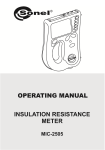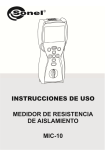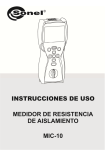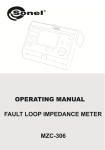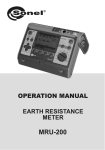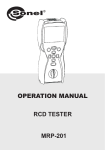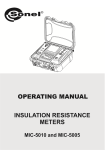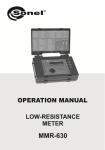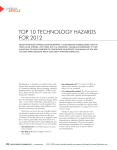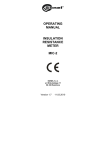Download User Manual
Transcript
OPERATING MANUAL
EARTH RESISTANCE METER
MIC-2501
SONEL S.A.
ul. Wokulskiego 11
58-100 Świdnica, Poland
Version 1.00 15.06.2015
MIC-2501 meter is a modern, high quality, easy to use and safe measuring device. Please acquaint
yourself with this manual in order to avoid measuring errors and prevent possible problems in operation of the meter.
2
OPERATING MANUAL MIC-2501 version 1.00
CONTENTS
1
SAFETY ....................................................................................................................5
2
TURNING THE METER ON AND ACTIVATING SCREEN BACKLIGHT. .6
3
METER CONFIGURATION ..................................................................................6
4
MEASUREMENTS ..................................................................................................8
4.1
MEASUREMENT OF INSULATION RESISTANCE ...........................................................8
4.1.1
Double-lead measurement .............................................................................8
4.1.2
Three-lead measurement .............................................................................13
4.2
LOW-VOLTAGE MEASUREMENT OF RESISTANCE ......................................................14
4.2.1
Measurement of resistance of protective conductors and equipotential
bonding with ±200 mA current ....................................................................14
4.2.2
Compensation of test leads resistance .........................................................15
4.3
VOLTAGE MEASUREMENT .....................................................................................16
5
MEMORY OF MEASUREMENT RESULTS ....................................................18
5.1
STORING THE MEASUREMENT RESULTS IN THE MEMORY .........................................18
5.2
VIEWING MEMORY DATA .......................................................................................20
5.3
DELETING MEMORY DATA .....................................................................................21
5.3.1
Deleting bank data.......................................................................................21
5.3.2
Deleting the whole memory .........................................................................22
6
DATA TRANSMISSION .......................................................................................24
6.1
6.2
COMPUTER CONNECTION ACCESSORIES ................................................................24
DATA TRANSMISSION THROUGH USB PORT............................................................24
7
SOFTWARE UPDATES........................................................................................24
8
POWER SUPPLY ..................................................................................................25
8.1
8.2
8.3
MONITORING THE POWER SUPPLY VOLTAGE ..........................................................25
CHARGING THE BATTERY PACK .............................................................................25
GENERAL PRINCIPLES REGARDING USING NI-MH RECHARGEABLE BATTERIES ........26
9
CLEANING AND MAINTENANCE ...................................................................27
10
STORAGE ..............................................................................................................27
11
DISMANTLING AND DISPOSAL ......................................................................27
12
TECHNICAL SPECIFICATIONS .......................................................................27
12.1 BASIC DATA..........................................................................................................27
12.2 ADDITIONAL DATA ................................................................................................29
12.2.1
Additional uncertainties according to IEC 61557-2 (RISO) ..........................29
12.2.2
Additional uncertainties according to IEC 61557-4 (R ±200 mA) ..............29
OPERATING MANUAL MIC-2501 version 1.00
3
13
ACCESSORIES ......................................................................................................30
13.1
13.2
STANDARD EQUIPMENT ........................................................................................30
OPTIONAL ACCESSORIES .......................................................................................30
14
MANUFACTURER ...............................................................................................31
15
LABORATORY SERVICES ................................................................................32
4
OPERATING MANUAL MIC-2501 version 1.00
1
Safety
MIC-2501 meter is designed for performing check tests of protection against electric shock in
mains systems. The meter is used for making measurements and providing results to determine safety
of electrical installations. Therefore, in order to provide conditions for correct operation and accuracy
of obtained results, the following recommendations must be observed:
Before you proceed to operate the meter, acquaint yourself thoroughly with the present manual
and observe the safety regulations and specifications provided by the producer.
Any application that differs from those specified in the present manual may result in a damage to
the device and constitute a source of danger for the user.
MIC-2501 meters must be operated only by appropriately qualified personnel with relevant certificates authorising the personnel to perform works on electric systems. Unauthorized use of the meter may result in its damage and may be a source of serious hazard to the user.
During measurements of insulation resistance, dangerous voltage of approx. 2.5kV occurs at the
ends of measurement wires of the meter.
Before the measurement of insulation resistance you must be sure that tested object is disconnected from the power supply.
During the measurement of insulation resistance do not disconnect test leads from the tested object before the measurement is completed (see par. 4.1); otherwise the capacitance of the object
will not be discharged, creating the risk of electric shock.
Using this manual does not exclude the need to comply with occupational health and safety regulations and with other relevant fire regulations required during the performance of a particular type
of work. Before starting the work with the device in special environments, e.g. potentially firerisk/explosive environment, it is necessary to consult it with the person responsible for health and
safety.
It is unacceptable to operate the device when:
a damaged meter which is completely or partially out of order,
a meter with damaged insulation,
a meter stored for an excessive period of time in disadvantageous conditions (e.g. excessive
humidity).If the meter has been transferred from a cool to a warm environment with a high level
of relative humidity, do not start measurements until the meter is warmed up to the ambient
temperature (approximately 30 minutes).
Remember that bAt message appearing on the display indicates insufficient voltage of power
supply and the need to recharge the batteries.
Message ErrX displayed in the main field, where X is a number from 0 to 9, indicate incorrect operation of the meter. If after restarting the device this situation is repeated - it indicates that the
meter is damaged. Please contact the manufacturer's service.
Before measurement, choose a correct measurement function and make sure that test leads are
connected to respective measuring terminals.
Do not power the meter from sources other than those listed in this manual.
The RISO inputs of the meter are protected electronically from overload (e.g. due to having been
connected to a live circuit) up to 750V rms for 60 seconds.
Repairs may be performed only by an authorised service point.
Note:
Due to continuous development of the meter’s software, the actual appearance of the display,
in case of some of the functions, may slightly differ from the display presented in this operating manual.
OPERATING MANUAL MIC-2501 version 1.00
5
2
Turning the meter ON and activating screen backlight.
Turn on the meter with
button.
Short press
button to turn the
screen backlight on; press the button
again to turn the backlight off.
Switch on the meter by pressing and
and holding
sec.
Emergency
situations.
button for approx. 2
Pressing
button for approx. 7
seconds will turn off the meter in case
of emergency.
3
Meter Configuration
Turn on the meter by pressing and
keeping SETUP button pressed.
Use buttons
and
to set Auto-OFF
time or to inactivate this function (horizontal lines – Auto-OFF function is inactive).
Auto-OFF function is used to turn-off inactive meter after a preselected time.
Use
and
buttons to enter the
screen with audio message settings:
bEEP.
6
OPERATING MANUAL MIC-2501 version 1.00
Use
and
buttons to turn the audio
messages ON ( ) or OFF (
).
Press
and
buttons to enter the setting the type of absorption coefficients:
FAC.
Use
and
buttons to set Ab1, Ab2 (
) parameters or PI, DAR ( ).
Use
and
buttons to enter the
screen with software update: UPdt.
OPERATING MANUAL MIC-2501 version 1.00
7
Press ENTER to enter the update mode. The
update process is described in Chapter 7
After changing the parameters, you may exit SETUP menu (not applicable for
Update screen):
Press ENTER to memorize settings
or use ESC button to go to the measurement
screen without approving the changes.
4
Measurements
4.1 Measurement of insulation resistance
WARNING:
The tested object must not be live.
Attention:
During measurement, especially of high resistances, make sure that test leads
do not touch each other and probes (crocodile clips), because such a contact
may cause the flow of surface currents resulting in additional error in measurement results.
4.1.1 Double-lead measurement
Use << or >> button to start the measurement of RISO (LED
is on). The
meter is in voltage measurement mode.
Press SET/SEL button to select the measurement voltage UISO, time used for calculating the
absorption coefficients t1, t2, t3 and the interval between the parameter points ChA.
Use
and
buttons to set UISO value
and confirm it by pressing ENTER
or
8
OPERATING MANUAL MIC-2501 version 1.00
use
button to enter the setting of
times for calculating the absorption coefficients.
Use
use
and
buttons to set t1 value,
button to start setting t2 and then
t3 value. Press
again to enter the setting of time interval ChA of recording
RISO.
Use
and
buttons to set the interval (15, 30 or 60 sec.). Horizontal lines
indicate unavailability of recording characteristics.
or
Press ENTER to confirm settings or
press ESC to exit without saving the
changes.
OPERATING MANUAL MIC-2501 version 1.00
9
Connect test leads according to the drawing.
The meter is ready
for measurement.
Press and hold START push-button.
The measurement is performed continuously until you release the button or the
pre-set time is reached.
for 5 sec.
or
+
10
In order to maintain (hold) the measurement, press and hold START button for 5
sec. or press ENTER while holding
START button pressed - symbol
will be displayed indicating
automatic measurement, now the buttons
may be released. The measurement will
end after the longest pre-set time (t1, t2
or t3) runs out. To interrupt or terminate
the measurement earlier in the absence
of pre-set t1, t2 or t3 values (measurement without time limit), press again
START or ESC button.
OPERATING MANUAL MIC-2501 version 1.00
View of the screen during
measurement.
means that the measurement was started with
ENTER button or by pressing and holding START button for approx. 5 sec.
Use SET/SEL to go to display leakage current IL.
After the measurement is
completed or stopped,
read the result. The results of all completed
measurements will be displayed (even when the
measurement was interrupted/stopped e.g. after
60 seconds). When the
meter switched into
standby mode, the measurement result may be recalled by pressing
ENTER.
Use
and
to see individual components of the
result in the following order:
RISO→IL→Ab2→Ab1→Rt3→It3→Rt2→It2→Rt1→It1
→RISO.
If the measurement is stopped, the displayed values will present the results of partial measurements
that have been completed and "---" will represent
uncompleted partial measurements.
If the characteristic was measured, then the measurement results may be read between It1 and RISO.
OPERATING MANUAL MIC-2501 version 1.00
11
Note:
During measurements of insulation resistance, dangerous voltage of approx.
2.5kV occurs at the ends of measurement wires of MIC-2501 meter.
It is forbidden to disconnect test leads before the measurement is completed.
Failure to obey the above instruction will lead to high voltage electric shock and
make it impossible to discharge the tested object.
- Disabling t2 will also disable t3.
- Timer measuring the measurement time is started when UISO voltage is stabilized.
- Symbol LIMIT means operation with limited inverter power. If this condition persists for 20 seconds,
the measurement is interrupted.
- If the timer reaches characteristic points (tx times or characteristic times), then for 1s instead U ISO a
symbol (mnemonic) of this point is displayed which is accompanied by a long beep.
- During the measurement LED is flashing in yellow.
- When the measurement is complete, capacity of the tested object is discharged by shorting terminals
RISO+ and RISO- with resistance of approx. 100 k. Message „diS” is displayed. Do not disconnect the
test leads before the object capacity id discharged.
- When during viewing the results, voltage is present at terminals RISO, LED RISO will blink in red and
additional two-tone beep will be generated.
- In case of power cables measure the insulation resistance between each conductor and other conductors shorted and grounded (figure below).
12
OPERATING MANUAL MIC-2501 version 1.00
Additional information displayed by the meter
Test voltage is present on terminals of the meter.
NOISE!
READY disappears, LED
lights red, two-tone beep
LIMIT I!
, RISO LED is
blinking in red and twotone acoustic signal is
generated
Interference voltage higher than 25V but lower than 50V, is present on the tested object. Measurement is possible but may be
burdened with additional uncertainty.
Interference voltage higher than 50 V, is present on the tested object. The measurement is blocked.
Activation of current limit. The symbol displayed is accompanied
by a continuous beep.
Breakdown of the tested object insulation, the measurement is interrupted. The message appears after displaying LIMIT I! for 20 s
during the measurement, when the voltage previously reached the
nominal value.
During the measurement, AC voltage appeared or the object cannot be discharged for 30 seconds. Immediately disconnect the
test leads.
4.1.2 Three-lead measurement
In order to eliminate the influence of surface resistance in transformers, cables, etc. the
three-lead measurement is used. For example:
at the measurement of inter-winding resistance of a transformer, G socket of the meter should
be connected to the transformer tank;
when measuring insulation resistance between one of the cable conductors and the cable jacket, the effect of surface resistances (important in difficult weather conditions) is eliminated by
connecting a piece of metal foil insulating the tested conductor with G socket of the meter;
OPERATING MANUAL MIC-2501 version 1.00
13
Cable sheath
Metal foil wrapped around the conductor insulation
Conductor
The same shall apply when measuring the resistance between two conductors of the cable, attaching to G terminal other conductors that do not take part in the measurement.
4.2 Low-voltage measurement of resistance
4.2.1 Measurement of resistance of protective conductors and equipotential bonding with ±200 mA current
Use << or >> button to start the measurement of RCONT
(LED
is on). The meter is in the voltage measurement mode.
The meter is ready for
measurement.
Connect the meter to the tested object.
Trigger the measurement by pressing the START button.
14
OPERATING MANUAL MIC-2501 version 1.00
Read out the result.
Press START push-button in order to start next measurement without disconnecting test leads from the object.
Additional information displayed by the meter
Interference voltage occurs on the tested object. The
measurement is possible however it will be burdened
with additional uncertainty that is specified in the technical data.
NOISE!
, LED
RCONT is blinking
in red and twotone acoustic signal is generated
Interference voltage exceeds the allowable value, the
measurement is blocked.
4.2.2 Compensation of test leads resistance
In order to eliminate the impact of the resistance of test leads on measurement result RCONT, the
compensation (auto-zeroing) of resistance may be performed.
In RCONT mode (LED
is on) use SET/SEL button to enter the screen with Autozeroing the test leads.
OPERATING MANUAL MIC-2501 version 1.00
15
Short the test
leads – message
READY will be
displayed.
Press START.
AUTO-ZERO message starts to
blink, which confirms completion
of test leads calibration.
The result is a compensated value and correction is available for
RCONT. The compensation is active even after the meter is
switched off and on again.
In order to remove the compensation of the leads resistance (return to default
calibration), perform the above-mentioned activities with test leads open, instead
of test results, the display will show message oFF (compensation of test leads is
turned off).
Return to RCONT measurement screen by pressing
SET/SEL
4.3 Voltage measurement
Use << or >> button to start the measurement of
(LED
is on). The
meter is in the voltage measurement
mode.
16
OPERATING MANUAL MIC-2501 version 1.00
Connect the meter to a
voltage source.
Measurement is performed in a continuous manner.
Additional information displayed by the meter
>750V, LED is
blinking in red,
two-tone acoustic
signal is generated
~
-
Measuring range is exceeded. Voltage is higher than
acceptable. Immediately disconnect the test leads.
When AC voltage is detected, the device will display
symbol "~" ("wave") and when DC voltage is detected,
the device will display symbol "-" for negative polarity
or "nil" for positive polarity.
OPERATING MANUAL MIC-2501 version 1.00
17
5
Memory of measurement results
MIC-2501 meters have memory divided into 10 banks of 99 cells. Thanks to dynamic memory allocation, each of the memory cells can contain different quantity of single measurement results, depending on the needs. Optimal use of the memory can be ensured in this way. Each measurement result can be stored in a memory cell marked with a selected number and in a selected memory bank.
Thanks to this, the user of the meter can, at his/her option, assign memory cell numbers to individual
measurement points and the memory bank numbers to individual facilities. The user may also perform
measurements in any chosen sequence and repeat them without losing other data.
Memory of measurement results is not deleted when the meter is switched off. Thanks to this, the
data can be later read or sent to a computer. The number of a current memory cell or memory bank is
not changed either.
Note:
- Results of measurements performed for all measuring functions can be stored in one memory cell,
excluding U .
- After entering the measurement result, the ID number of the cell is automatically increased.
- It is recommended to delete the memory after reading the data or before performing a new series of
measurements that may be stored into the same memory cells as the previous ones.
5.1 Storing the measurement results in the memory
After completing measurement
press ENTER.
The cell is empty.
The cell is partially
occupied by the same
type of result, which
is to be entered.
18
OPERATING MANUAL MIC-2501 version 1.00
The cell is partially
occupied by a different type of result to
be entered - symbols
of the saved values
are displayed.
The cell is fully occupied, symbols (mnemonics) of stored values are displayed.
Use
and
buttons to preview the results
stored in the selected cell.
To change the cell number or bank number:
When the cell number is flashing, use
and
buttons to set the desired number of the
cell.
Press SET/SEL button – bank number is flashing.
Use
and
buttons to set the desired
number of the bank.
After selecting the desired bank and cell, press
ENTER button, to save the result in the memory. Recording is indicated by a triple beep.
Press ESC to return to the measurement screen
without saving.
If you try to store data in an occupied memory cell, the following
warning message will appear:
OPERATING MANUAL MIC-2501 version 1.00
19
Press ENTER, to overwrite the result or ESC, to cancel and select
other cell or bank.
or
Note:
- After the measurement, its result is shown on the display until:
the measurement function is changed,
Auto-OFF function is activated,
the meter detects interference voltage> 50V,
one of the following operations is performed:
o
ESC button is pressed to exit to the voltmeter,
o
next measurement is performed,
o
an entry into the memory is introduced.
- After exiting to the voltmeter by pressing ESC or after saving the results to the memory, the last result may be recalled by pressing ENTER.
- Complete set of results (main result and supplementary results) for a given measuring function and
preset measurement settings are stored in the memory.
5.2 Viewing memory data
Use << or >> to browse the memory: MEM
(LED
is on).
Use
and
buttons to preview the results
stored in the selected cell.
To change the cell number or bank number:
When the cell number is flashing, use
and
buttons to set the desired number of the
cell.
Press SET/SEL button – bank number is flashing.
20
OPERATING MANUAL MIC-2501 version 1.00
Use
and
buttons to set the desired
number of the bank.
Note:
- While viewing RISO results, the field of timer / memory displays alternately bank and cell numbers and
the time in which the result was entered into memory. This applies to all R ISO and IL measurements.
- Press ESC to immediately display basic component of the result.
- For RCONT there is no option of scrolling through the components of the result.
5.3 Deleting memory data
You can delete the entire memory or its individual banks.
5.3.1 Deleting bank data
Use << or >> to browse the memory:
MEM (LED
is on).
Set the bank number to
be deleted acc. to section 4.2.
Set the cell number as
"--" (before "01")...
... and the cell number
will change into "--",
then symbol
will be
displayed to indicate
the readiness for deleting.
Press ENTER button.
OPERATING MANUAL MIC-2501 version 1.00
21
and
symbols appear, asking
you to confirm deletion.
or
Press ENTER button again to delete
the selected bank.
After deleting the bank, the meter
beeps three times. Cancel by pressing
ESC.
The contents of the bank has been deleted.
5.3.2 Deleting the whole memory
Use << or >> to browse the
memory: MEM (LED
is on).
Set the bank number
as "--" (before "01")...
22
OPERATING MANUAL MIC-2501 version 1.00
… the bank number will
change into "--", then
symbol
will be displayed to indicate the
readiness for deleting
the whole memory.
Press ENTER button.
and
symbols appear, asking
you to confirm deletion.
or
Press ENTER again.
After deleting the memory, the meter
beeps three times.
The entire contents of the memory has been deleted.
OPERATING MANUAL MIC-2501 version 1.00
23
6
Data transmission
6.1 Computer connection accessories
In order to operate the meter with a PC, an USB cable and appropriate software are required. If
the required software has not been purchased with the meter, it may be downloaded from the manufacturer's website or purchased form the manufacturer or its authorised distributor.
The software may be used for many devices manufactured by SONEL S.A. which are equipped
with the USB interface or other (depending on the selected device).
Detailed information is available from the manufacturer and distributors.
6.2 Data transmission through USB port
1.
Use << or >> to browse the memory: MEM (LED
is on).
2. Connect the cable to the USB port of the computer and the USB socket of the meter. The meter will
displays the message:
3. Start the program for communicating with the meter (processing results) and follow the commands
of the software.
7
Software updates
1. In accordance with the guidelines of Section 3 of this manual, enter the meter software update
mode: UPdt
2. Connect the cable to the USB port of the computer and the USB socket of the meter.
3. Start the program for updating the meter and follow the commands of the software.
24
OPERATING MANUAL MIC-2501 version 1.00
8
Power supply
8.1 Monitoring the power supply voltage
The charge level of the battery pack is indicated by the symbol in the right upper corner of the display on a current basis:
The battery pack is charged.
The charge of battery pack is low. Only voltage measurement is
available.
No battery icon (when the charger is connected). The battery
pack is disconnected or damaged.
The battery pack is fully discharged, all measurements are
blocked.
The meter switches off automatically after 5 sec.
8.2 Charging the battery pack
CAUTION!
MIC-2501 meter is powered from SONEL battery pack, which includes NiMH 9.6
V batteries and it may be replaced only by the manufacturer's service department.
Battery charger is installed inside the meter and cooperates only with the manufacturer’s rechargeable battery pack. The charger is powered by external power supply adapter. The device may
be also powered from the car cigarette lighter socket (12V only), using an optional charger.
Charging commences once the power supply has been connected to the meter regardless of the
fact whether the meter is on or off (only the charging mode is different - as described below). When
the meter is switched off - the charging process is indicated on the screen by displaying animated
symbol of battery being charged; when the meter is switched off - the charging is indicated by blinking
LED's of measurement functions (they blink consecutively in red).
Charging modes:
- the meter (user interface) is switched off: the battery pack is charged in "quick charging" mode - the
charging process takes approx. 4 hours. Completed charging is indicated by full battery symbol, FULL
message and beep. In order to fully turn the device off, unplug the power charger.
- the meter (user interface) is switched on: the battery pack is charged in "background charging" mode
- the charging may be longer than the charging process of the device which is switched off. Completed
charging is indicated by full battery symbol and beep. If the charging time exceeds 10 hours, the meter will automatically switch off for safety reasons.
In order to fully turn the device off, unplug the power charger and turn the meter off.
CAUTION!
Do not power the meter from sources other than those listed in this manual.
OPERATING MANUAL MIC-2501 version 1.00
25
Note:
- Due to interferences in the mains, the process of battery pack charging may finish prematurely. When
charging time is too short, turn off the meter and start charging again.
Additional information displayed by the meter
Signalling
Displayed message: Err ACU
Hi°C
Displayed message: Err ACU
Lo°C
Cause
Temperature of the battery pack is too high!
Temperature of the battery pack is too low.
Displayed message: Err ACU X
(where X is the number of error)
Emergency
No battery icon (when the
charger is connected)
The battery pack is disconnected or damaged.
Solution
Wait until the battery pack is cool. Start
charging process again.
Wait until the battery pack is warm
enough. Start charging process again.
Try to start the charging process again.
When powering the device from the
cigarette lighter socket, check whether
the socket supplies 12V voltage. If this
does not help, the battery pack may be
damaged - contact the manufacturer's
service.
Contact the manufacturer's service.
8.3 General principles regarding using Ni-MH rechargeable batteries
- Store the he rechargeable batteries (the meter) in a dry, cool and well ventilated place and protect
them from direct sunlight. The temperature of the environment in the case of prolonged storage should
not exceed 30°C. If the rechargeable batteries are stored for a long time in a high temperature, then
the occurring chemical processes may reduce their lifetime.
- Rechargeable batteries NiMH usually lasts for 500-1000 charging cycles. The rechargeable batteries
reach their maximum capacity after being formatted (2-3 charge and discharge cycles). The most important factor which influences the lifetime of rechargeable batteries is the level of their discharge. The
deeper the discharge level of the batteries, the shorter their lifetime.
- The memory effect is limited in the case of NiMH batteries. These batteries may be charged at any
point with no serious consequences. However, it is recommended to discharge them completely every
few cycles.
- During storage of Ni-MH rechargeable batteries they are discharged at the rate of approximately 20%
per month. Keeping rechargeable batteries at high temperatures may accelerate this process even
100%. In order to prevent excessive discharge of rechargeable batteries, after which it would be necessary to format them, it is recommended to charge them from time to time (even if they are not used).
- Modern fast chargers detect both too low and too high a temperature of the battery pack and react to
the situation adequately. Too low temperature should prevent starting the process of charging, which
might irreparably damage rechargeable batteries. An increase of the temperature of the rechargeable
batteries is a signal to stop charging and is a typical phenomenon. However charging at a high ambient temperature apart from reducing batteries' lifetime causes an accelerated increase of their temperature and the result is that the batteries are not charged to their full capacity.
- Please note that when the batteries are charged with a fast-charger they are charged only to approx.
80% of their capacity - better results can be achieved by continuing charging: the charger enters trickle-charging mode and during the next few hours batteries are charged to their full capacity.
26
OPERATING MANUAL MIC-2501 version 1.00
- Do not charge or use the batteries in extreme temperatures. Extreme temperatures reduce the lifetime of batteries and rechargeable batteries. Avoid placing devices powered by rechargeable batteries
in very hot environments. The nominal working temperature must be absolutely observed.
9
Cleaning and maintenance
CAUTION!
Use only the maintenance methods specified by the manufacturer in this manual.
The casing of the meter may be cleaned with a soft, damp cloth using all-purpose detergents. Do
not use any solvents or cleaning agents which might scratch the casing (powders, pastes, etc.).
Clean the probe with water and dry it. Before the probe is stored for a prolonged period of time it is
recommended to grease it with any machine lubricant.
The reels and test leads should be cleaned with water and detergents, and then dried.
The electronic system of the meter does not require maintenance.
10 Storage
In the case of storage of the device, the following recommendations must be observed:
Disconnect all the test leads from the meter.
Clean the meter and all its accessories thoroughly.
Wind the long test leads onto the reels.
In order to prevent a total discharge of the battery pack in the case of a prolonged storage, charge
it from time to time.
11 Dismantling and Disposal
Worn-out electric and electronic equipment should be gathered selectively, i.e. it must not be
placed with waste of another kind.
Worn-out electronic equipment should be sent to a collection point in accordance with the law of
waste electrical and electronic equipment.
Before the equipment is sent to a collection point, do not dismantle any elements.
Observe local regulations concerning disposal of packages, waste batteries and accumulators.
12 Technical specifications
12.1 Basic data
Abbreviation "m.v." used in the specification of basic uncertainty means standard measured value
AC / DC voltage measurement
Display range
Resolution
0…750 V
1V
Frequency range for AC: 45 Hz...65 Hz
Basic uncertainty
(3% m.v. + 2 digits)
Measurement of insulation resistance
Measuring range according to IEC 61557-2: RISOmin = UISOnom/IISOnom …1000 G (IISOnom = 1 mA)
OPERATING MANUAL MIC-2501 version 1.00
27
Double-lead measurement
Display range
Resolution
Basic uncertainty
0.0 k...999.9 k
0.1 k
1.000 M...9.999 M
0.001 M
10.00 M...99.99 M
0.01 M
100.0 M...999.9 M
0.1 M
(3 % m.v. + 20 digits)
1.000 G...9.999 G
0.001 G
10.00 G...99.99 G
0.01 G
100.0 G...999.9 G
0.1 G
1000 G
1 G
When the range is exceeded, the device displays ">xxxxGΩ" (where xxxx is the limit value for
the selected range).
Approximate maximum values of the measured resistance, depending on the test voltage, are
presented in the table below. For other voltages the range limits may be read from the chart below.
Voltage
up to 100 V
200 V…400 V
500 V…900 V
1000 V…2400 V
2500 V
Test range
50 G
100 G
250 G
500 G
1000 G
Note: For insulation resistance below RISOmin there is no accuracy specified because the meter
works with the adjustable current limit in accordance with the following formula:
RISO min
UISO nom
IISOnom
where:
RISOmin
UISOnom
IISOnom
– minimum insulation resistance measured without limiting the converter current
– nominal test voltage
– nominal inverter current (1 mA)
Measurement of leakage current
Display range
Resolution
0…ILmax
m, μ, n
Basic uncertainty
Calculated basing on resistance measurements
ILmax – maximum current at short circuit of leads,
resolution and units result from the measurement range of individual insulation resistance.
Low-voltage measurement of continuity of circuit and resistance
Measurement of continuity of protective conductors and equipotential bondings with 200 mA
current
Measuring range according to IEC 61557-4: 0.10 …999
Display range
Resolution
Basic uncertainty
0.00 ...19.99
0.01
(2% m.v. + 3 digits)
20.0 ...199.9
0.1
200 ...999
1
(4% m.v. + 3 digits)
Voltage at open terminals: 4 V…24 V
Output current at R < 2: ISC > 200 mA
28
OPERATING MANUAL MIC-2501 version 1.00
Compensation of test leads resistance
Measurements for both current polarizations.
When the range is exceeded, the device displays "> 999 Ω" message
Other technical data
a) type of insulation .......................................................... double, acc. to EN 61010-1 and IEC 61557
b) measurement category .................................................... IV 600 V (III 1000 V) acc. to EN 61010-1
c) degree of housing protection acc. to EN 60529......................................................................... IP65
d) power supply of the meter................................................... SONEL battery pack, NiMH 9.6 V 2 Ah
e) Battery charging time .................................................................................... usually 4 h, max. 10 h
f) parameters of the external power supply adapter ................................ 90 V…264 V, 50 Hz…60 Hz
g) dimensions .......................................................................................... 200 mm x 150 mm x 75 mm
h) meter weight ............................................................................................................. approx. 1.0 kg
i) allowable batter pack charging temperatures in mode 500mA ................................ +10 °C...+40 °C
j) temperatures at which the charging process is interrupted ................................ <0 °C and ≥ +50 °C
k) operating temperature range with external power supply adapter ...................... <0 °C and ≥ +50 °C
l) storage temperature ................................................................................................ -20 C...+60 C
m) operating temperature ............................................................................................. -15 C...+40 C
n) humidity ....................................................................................................................... 20 %...80 %
o) reference temperature ...............................................................................................+23 C ± 2 C
p) reference humidity ....................................................................................................... 40 %...60 %
q) altitude (above sea level) .................................................................................................. <2000 m
r) number of measurements RISO acc. to PN-EN 61557-2..................................................approx. 800
s) modular ................................................................................................................................... LCD
t) memory of measurement results ....................................................................................... 990 cells
u) data transmission .................................................................................................. USB connection
v) quality standard ... design, construction and manufacturing are ISO 9001, ISO 14001, PN-N-18001
compliant
w) the device meets the requirements of IEC 61557 standard
x) the product meets EMC requirements (immunity for industrial environment) according to the following standards............................................................ EN 61326-1:2013 and EN 61326-2-2:2013
12.2 Additional data
Data on additional uncertainties are useful mainly when the meter is used in non-standard conditions and for metrological laboratories for the purpose of calibration.
12.2.1 Additional uncertainties according to IEC 61557-2 (RISO)
Significant parameter
Position
Supply voltage
Temperature 0 C...35 °C
Designation
E1
E2
E3
Additional uncertainty
0%
0% (BAT is not lit)
0.1 %/ºC
12.2.2 Additional uncertainties according to IEC 61557-4 (R ±200 mA)
Significant parameter
Position
Supply voltage
Temperature 0 C...35 °C
Designation
E1
E2
E3
Additional uncertainty
0%
0.5% (BAT is not lit)
1.5%
OPERATING MANUAL MIC-2501 version 1.00
29
13 Accessories
13.1
Standard equipment
The standard set of equipment supplied by the manufacturer includes:
MIC-2501 meter – WMPLMIC2501
shielded wire 1.8 m, 5 kV, ended with banana plugs, black (cat. IV 1 kV) - WAPRZ1X8BLBB
shielded wire 1.8 m, 5 kV, ended with banana plugs, red (cat. IV 1 kV) – WAPRZ1X8REBB
shielded wire 1.8 m, 5 kV, ended with banana plugs, blue (cat. IV 1 kV) – WAPRZ1X8BUBB
crocodile clip, 5,5 kV, black (cat. IV 1 kV) – WAKROBL32K07
crocodile clip, 5,5 kV, red (cat. IV 1 kV) – WAKRORE32K07
crocodile clip, 5,5 kV, blue (cat. IV 1 kV) – WAKROBU32K07
probe 5 kV, red (cat. IV 1 kV), – WASONREOGB2
probe 5 kV, black (cat. IV 1 kV) – WASONBLOGB2
external adapter for battery pack charging – WAZASZ7
USB cable – WAPRZUSB
case – WAFUTM8
calibration certificate
operating manual
guarantee card.
13.2
Optional accessories
Additionally, the following items that are not included in the scope of standard equipment
can be purchased from the manufacturer or the distributors:
WAPRZ005BLBBE5K
WAPRZ010BLBBE5K
5 m shielded cable, black, cat. IV 1000 V
10 m shielded cable, black, cat. IV 1000 V
WAPRZ005REBB5K
WAPRZ010REBB5K
5kV cable, 5m, red, with banana plugs
WAPRZ005BUBB5K
WAPRZ010BUBB5K
5kV cable, 5m, blue, terminated with ba-
nana plugs
WASONPRS1PL
5kV cable, 10m, blue terminated with banana plugs
WAPRZLAD12SAM
probe insulation resistance of floors and
walls PRS-1
30
5kV cable, 10 m, red, with banana plugs
cable for charging the battery pack from
the car cigarette lighter socket (12V)
OPERATING MANUAL MIC-2501 version 1.00
WAPROSONPE5
WAADACS1
cable simulator CS-1
LSWPLMIC2501
"SONEL Pomiary Elektryczne" (SONEL
Electrical Measurements) - software for
generating measurement reports
calibration certificate
Note
The software is supported by the following systems: Windows XP (Service Pack 2) or
later.
14 Manufacturer
The manufacturer of the device and provider of guarantee and post-guarantee service:
SONEL S.A.
ul. Wokulskiego 11
58-100 Świdnica
Poland
tel. +48 74 858 38 60
fax +64 74 858 38 09
E-mail: [email protected]
Web page: www.sonel.pl
Note:
Service repairs must be performed only by the manufacturer.
OPERATING MANUAL MIC-2501 version 1.00
31
15 Laboratory services
Measurement Laboratory of SONEL SA offers tests and certification of the following instruments in the scope of their electrical/non-electrical features:
-
-
infra-red cameras,
pyrometers,
meters for conducting the following electrical protective measurements: insulation resistance, earth resistance and impedance, short-circuit loops, RCD parameters and multifunctional meters that perform the above functions,
electrical safety meters,
power quality analysers,
meters for measuring low resistance values,
voltage meters, current meters (including clamp meters), resistance meters and multimeters,
light meters.
A calibration certificate is a document confirming compliance of parameters declared by
the manufacturer of tested device with national standards, specifying the measurement uncertainty
In accordance with PN-ISO 10012-1, Annex A – "Requirements for assuring quality of
measurement equipment. The system for approving metrological measuring equipment" –
SONEL S.A. recommends for its instruments to be periodically tested, observing -- 13-month
intervals.
For new devices with calibration certificates, the next metrological inspection (calibration)
is recommended within 13 months from the date of purchase, but not later than 19 months
from the date of manufacture.
Note:
In case of instruments used for tests related to the protection against electric
shock, the person performing measurements should have complete confidence in
the efficiency of operated apparatus. Measurements carried out with malfunctioning meter may cause wrong assessment of tested equipment in terms of its protection features.
32
OPERATING MANUAL MIC-2501 version 1.00





































